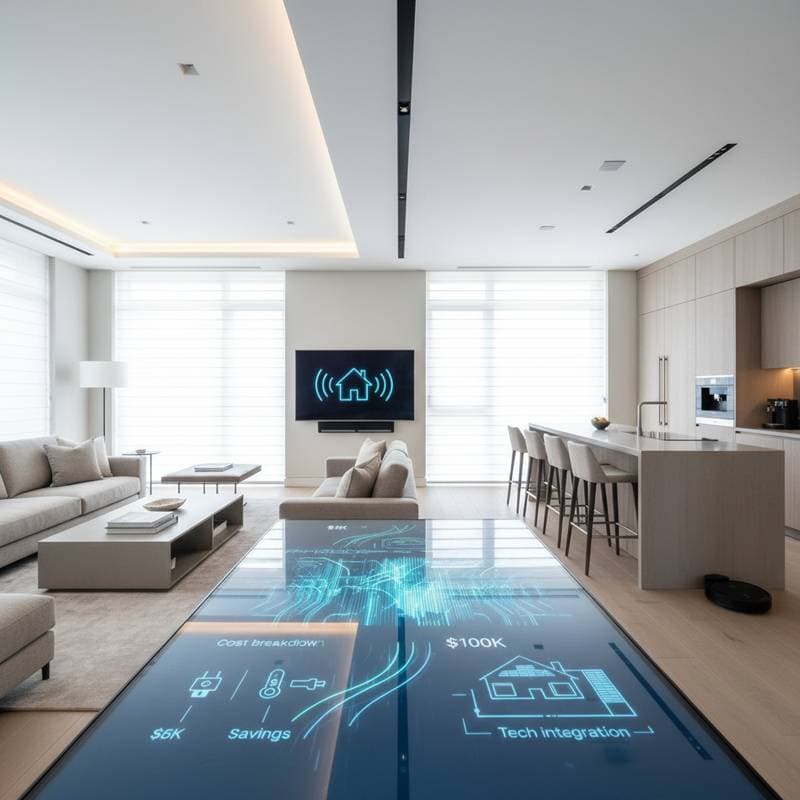The 2025 Smart Home Remodel Costs You Need to Know
Homeowners in 2025 can transform their living spaces into efficient, connected environments without excessive spending. A realistic budget and strategic planning make the difference. Smart home remodeling now combines automation, energy efficiency, and security with conventional renovations. Understanding cost allocation ensures that each investment yields maximum benefit.
Key Points
- Entry-level smart home remodels begin at $5,000 to $10,000 for foundational systems.
- Mid-range projects range from $20,000 to $50,000, influenced by home size and chosen devices.
- Comprehensive integrations, encompassing HVAC, lighting, and security, may exceed $100,000.
- Many upgrades provide tangible energy reductions and elevated property values.
- Thorough planning, permitting, and compatibility assessments guarantee enduring performance.
Budget Breakdown by Project Type
1. Smart Lighting and Power
Smart lighting represents an accessible entry point for upgrades. Homeowners replace conventional switches with dimmers, motion sensors, and voice-activated bulbs at a cost of $1,000 to $3,000 in a typical three-bedroom home. Professional installation of an app-controlled system elevates expenses to $5,000 or higher, including custom zoning for rooms.
Select platforms compatible with open standards like Zigbee or Z-Wave. These choices facilitate integration with emerging devices and prevent the need for full system overhauls in the future.
2. Smart Climate Control
Smart thermostats and linked HVAC setups require an investment of $2,500 to $7,500, varying with the extent of zoning and existing duct modifications. Adding intelligent vents and sensors that respond to occupancy increases costs by $1,000 to $2,000. Such enhancements typically recover their expense via reduced utility bills within three to five years.
Professional assistance proves essential for systems involving heat pumps or multiple zones. Improper wiring risks warranty invalidation and equipment failure.
3. Security and Surveillance
Core elements include smart locks, cameras, and detectors, forming a robust defense layer. A self-installed basic array runs $1,500 to $3,000, covering door access and perimeter monitoring. Professional configurations with central monitoring and advanced alerts climb to $8,000 to $12,000, incorporating 24-hour response capabilities.
Engage licensed specialists for regulated installations. Certain jurisdictions classify networked security as requiring certified professionals to ensure compliance and reliability.
4. Entertainment and Connectivity
Upgrades in this category often appeal to those prioritizing leisure. A straightforward multi-room audio setup or basic home theater demands about $3,000, including speakers and a control interface. Premium installations, complete with soundproofing and immersive displays, surpass $20,000 for larger spaces.
- Assess Wi-Fi signal strength throughout the property.
- Map out wiring paths prior to completing interior walls.
- Install comprehensive surge safeguards for all electronics.
These steps prevent connectivity issues and protect investments from power fluctuations.
5. Whole-Home Automation
True integration demands a central hub orchestrating all functions, starting at $25,000 for standard homes. Expansive properties with intricate setups in lighting, security, and climate control approach $100,000, factoring in custom programming and redundant backups.
Advanced systems synchronize operations effortlessly, from automated evening routines to energy-optimizing schedules. The result streamlines household management while minimizing waste.
Calculating Return on Investment
Smart remodels elevate home worth, though returns vary by feature and implementation. Energy-focused additions, such as thermostats and LED integrations, reclaim 60 to 80 percent of costs through ongoing savings on electricity and heating. Security enhancements and comfort features offer indirect gains by attracting discerning buyers.
Focus on universally appealing elements like automated environmental controls and intrusion detection. These outperform specialized media setups in boosting market desirability and sale prices.
Strategies for a Successful Remodel
Develop a detailed blueprint illustrating device interconnections before purchasing components. Opt for versatile ecosystems that accommodate devices from diverse brands, enhancing flexibility.
Secure accounts with distinct passwords and two-factor verification to safeguard against breaches. Incorporate expandable infrastructure, such as additional conduits, even in initial phases.
Regular upkeep sustains performance. Update software routinely and consult experts biennially for diagnostics.
Sustaining Long-Term Performance
Post-installation, monitor systems through monthly verifications and data backups. Professional inspections every two years address potential wear or obsolescence.
As technology evolves, component costs decline, enabling targeted enhancements without major disruptions. A forward-thinking approach today ensures adaptability and preserves equity over time.
Homeowners gain intuitive command over illumination, temperature, and protection via mobile or voice interfaces. This level of control defines the true advantage of a thoughtfully executed smart remodel.
